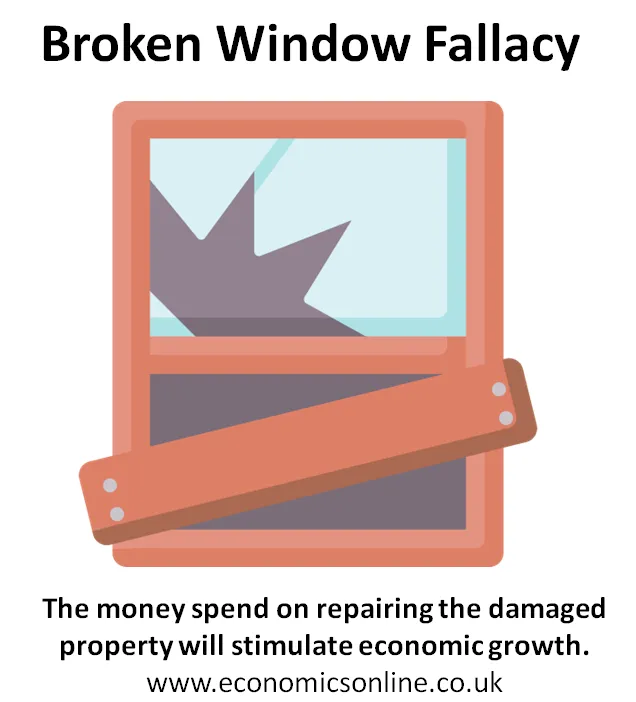
Photo by Tim Arterbury / Unsplash
Broken Window Fallacy
Definition
A concept that suggests that money spent on repairing the destruction or damage of a property can stimulate economic growth is called the broken window fallacy. This fallacy is an illusion, and it argues that repairing the broken window can create job opportunities and promote economic activity. This fallacy overlooks the fact that the resources used to repair the broken window can be used for other productive purposes. It is more beneficial for economic growth if the resources are used or invested in productive activities instead of repairing damages caused by destruction.

Explanation
The broken window fallacy revolves around the idea that when a window is broken, it creates work for the repairman, but it ignores the fact that the resources used in repairing the window could have been used for other productive purposes. The broken window fallacy reminds us to consider the unseen costs or opportunity costs of economic actions. It challenges the argument that destruction can encourage economic growth and emphasises the importance of long-term wealth creation.
Example
Suppose a shopkeeper’s square of glass window is broken by a careless child. People argue that a broken window is good for the economy as it creates job opportunities for glass repairmen and the glazier's trade is increased. The income of the repairmen is increased, hence the economic activity. But this is a fallacy because the money spent on repairing the broken panes of glass window by the unfortunate owner can be used to make new goods in the economy.

Does this mean that we should start breaking more windows? The answer is no.
The money spent on the subsequent repairs of the damaged window is not increasing economic welfare because nothing new is being produced. The repairmen may be better off, but overall net benefit is not increasing for society. This fallacy overlooks the opportunity cost (unseen cost) and the potential economic growth that could have been incurred if the window had not been broken.
Historical Background
The broken window fallacy is a concept in economics that has its roots in the work of French economist Claude-Frédéric Bastiat (1801 – 1850). Frederic Bastiat used the example of a broken window to illustrate and correct this fallacy.
Bastiat argues that while the immediate repair of a broken window may increase income for some people and hence economic activity, it fails to consider the unseen effects of this concept. The resources used for the repair could have been used for other transactions leading to the creation of additional economic benefits. Bastiat emphasises the importance of considering opportunity costs and unseen effects when analysing economic situations.
Importance of the Broken Window Fallacy
The following points explain the importance of the broken window fallacy:
Avoiding Misguided Economic Policies
The fallacy helps policymakers avoid misguided economic policies which say that destruction or damage can create job opportunities or stimulate economic growth.
Promoting Efficient Resource Allocation
The fallacy promotes the efficient allocation of resources by considering opportunity costs and the unseen effects of economic actions.
Encouraging Long-term Wealth Creation
By disproving this fallacy, we emphasise the importance of focusing on sustainable, long-term strategies to encourage economic growth and welfare.
Enhancing Economic Analysis
Fallacies encourage economic analysis and discussions, providing a more comprehensive evaluation of policies, behaviors, events, and their potential impacts.
Limitations of the Broken Window Fallacy
The following are major drawbacks of the broken window fallacy:
Oversimplification
The fallacy oversimplifies complex economic situations by focusing solely on the immediate visible effects of destruction or damage, neglecting or ignoring the unseen effects such as opportunity costs.
Ignoring Opportunity Costs
The fallacy ignores the opportunity costs, which are used as resources for repair, rather than promoting productivity and innovation by using the resources.
Neglecting Long-term Consequences
Fallacies neglect the long-term effects of destruction on overall economic growth and development.
Disregarding Wealth Redistribution
The fallacy disregards the fact that repairing broken windows redistributes wealth instead of producing new wealth, causing income instability.
The War Economy
An economic system influenced by and dependent on wartime economic activities and expenses incurred is called the war economy.
During wartime, the government allocates resources towards military production, defence spending, and mobilisation efforts. The war may be seen as good from the view of industry of war equipment, weapons and military grade automobiles because they will get more business and transactions. This increases GDP and may be considered as a source of economic well being.
Let's now explain war economy as an example of the broken window fallacy. Wars create destruction and damage, which need repair expenses. This repair after the war will increase GDP, but it is not being spent on producing new goods; rather, it is being spent on fixing the destruction to bring things back to where they were before the war.
The same logic can be used to explain the application of this fallacy for natural disasters, hurricanes, storms, floods, climate change, terror attack and other calamities.
Lost Sales Opportunities
When resources or investments are directed towards repairing or replacing broken windows or other forms of damage and destruction, this is known as lost sales opportunities. This loss of sales opportunities can lead to a neglect of other productive uses of resources, for example, the sales of new goods by other firms. The same resources could have generated additional sales for some other firms and stimulated economic growth through the encouragement of industry. By focusing only on the visible effects of the simple case of the broken window fallacy, it overlooks the net lost sales and loss of other opportunities as well.
GDP and Happiness
The relationship between GDP and happiness in the context of the broken window fallacy is explained below:
GDP and the Broken Window Fallacy
The broken window fallacy highlights the danger of solely relying on GDP as a measure of societal well-being and happiness. For example, after the war, the GDP increases because of higher spending on repairing the infrastructure, but that does create new wealth, and hence the happiness level in the economy may not increase. In fact, spending money on new products can create more satisfaction than doing repair work to fix the destruction or damage.
Unseen Consequences
The broken window fallacy reminds us to consider the unseen costs associated with focusing only on GDP growth. Higher GDP neglects the negative impacts on happiness, such as environmental degradation, income inequality, and social unrest.
Holistic Approach
To pursue happiness, we need to adopt a holistic approach. This approach considers a wide range of factors, such as health, education, social support, and personal fulfilment, instead of only focusing on economic output.
The Broken Window Fallacy and Keynesian Economics
emphasises
Keynesian economics emphasises the importance of government intervention, especially through fiscal policy, to encourage aggregate demand during economic downturns. It suggests that increased government spending can enhance economic activity and decrease the unemployment rate.
Government Role
Keynesian economics suggests that when there is a circumstance of economic downturn, the government should increase its spending and stimulate demand, even if it results in a budget deficit. This approach aims to explain the lack of private sector investment and spending.
Keynes and the Broken Window Fallacy
John Maynard Keynes argued that in cases of economic recession, the parable of the broken window should not be considered a fallacy. Even the Nobel prize winner Paul Krugman considered that war or a terror attack can do some economic good.
He argued that if an economy is in recession and undergoing a period of high unemployment and low confidence, spending money on repairing the broken window can stimulate economic activity. This will benefit the economy, which is undergoing a recession.
Conclusion
In conclusion, the broken window fallacy gives the wrongly taken lesson that destruction or damage can be beneficial for economic growth. In fact, people wrongly believe that the money spent on repairs can create economic growth. This fallacy is a good example of unintended consequences. The spending of money on repairs is not creating any wealth because, instead of making new products, the existing situation is being maintained. It is a fallacy to believe that destruction or war can potentially create economic growth and prosperity. In fact, the destruction destroys economic prosperity.


